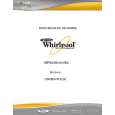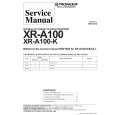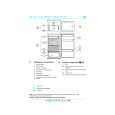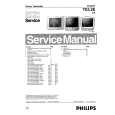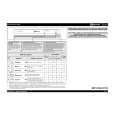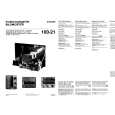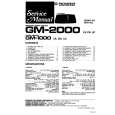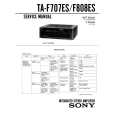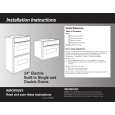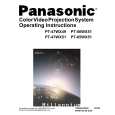|
|
|
Productos
|
|
Información
|
|
Destacado
|
|
|
 |
|
|
No hay comentarios de productos.
Important Safety Notice
Special components are used in this projection television that are important for safety. These components are identified on the schematic diagram by the symbol and printed in BOLD TYPE on the replacement part list. It is essential that these critical parts be replaced with the manufacturer�s specified replacement part to prevent x-ray radiation, shock, fire or other hazards. Do not modify the original design without the manufacturer�s permission.
Safety Precautions
General Guidelines
An isolation transformer should always be used during the servicing of a PTV whose chassis is not isolated from AC power line. Use a transformer of adequate power rating as this protects the technician from accidents resulting in personal injury from electrical shocks. It will also protect the PTV from being damaged by accidental shorting that may occur during servicing. When servicing, observe the original lead dress, especially in the high voltage circuit. Replace all damaged parts (also parts that show signs of overheating.) Always replace protective devices, such as fishpaper, isolation resistors and capacitors, and shields after servicing the PTV. Use only manufacturer�s recommended rating for fuses, circuits� breakers, etc. High potentials, as high as 32kV, are present when this PTV is operating. Operation of the PTV without the rear cover introduces danger for electrical shock. Servicing should not be performed by anyone who is not thoroughly familiar with the necessary precautions when servicing high-voltage equipment. Extreme care should be practiced when handling the picture tube. Rough handling may cause it to implode due to atmospheric pressure. (14.7 lbs. per sq. in.). Do not nick or scratch the glass or subject it to any undue pressure. When handling, use safety goggles and heavy gloves for protection. Discharge the picture tube by shorting the anode to chassis ground (not to the cabinet or to other mounting hardware). When discharging, connect cold ground (i.e. DAG ground lead) to the anode with a well-insulated wire or use a grounding probe. antenna terminals, control shafts, etc. If the exposed metallic part has a return path to the chassis, the reading should be between 240k and 5.2M . If the exposed metallic part does not have a return path to the chassis, the reading should be infinite. Leakage Current Hot Check (See Fig. 1) Plug the AC cord directly into the AC outlet. Do not use an isolation transformer during the check. Connect a 1.5k 10-watt resistor in parallel with a 0.15mF capacitor between and exposed metallic part and ground. Use earth ground, for example a water pipe. Using a DVM with a 1000 ohms/volt sensitivity or higher, measure the AC potential across the resistor. Repeat the procedure and measure the voltage present with all other expose metallic parts. Verify any potential does not exceed 0.75 volt RMS. A leakage current tester (such a Simpson Model 229, Sencore Model PR57 or equivalent) may be used in the above procedure, in which case any current measure must not exceed 0.5 milliamp. If any measurement is out of the specified limits, there is a possibility of a shock hazard and the PTV must be repaired and rechecked before it is returned to the customer.
X-ray Precautions
The front area (between the projection tube and the lens) is enclosed by a metal box to ensure positive safety during normal and abnormal conditions when checking and repairing. To fully ensure safety, the following precautions must be observed. 1. Do not remove the lens or metal box. 2. Make sure to turn the power OFF when the lens is removed or when checking the cleanliness of the lens. 3. Do not remove the lens or metal box to check the projection tube for operation by watching it directly. Use a mirror or paper to view the image. Before returning a serviced PTV to the owner, the service technician must thoroughly test the unit to ensure that is completely safe to operate. Do not use a line isolation transformer when testing. Figure 1. Hot Check Circuit
Insulation Test
Connect an insulation tester between an exposed metallic part and AC line. Apply 1080VAC/60Hz for 1 second. Confirm that the current measurement is 0.5mA ~ 2.0mA. Repeat test with other metallic exposed parts.
X-ray Radiation
WARNING: The potential source of X-ray radiation in the PTV is in the high voltage section and the picture tube. Note: It is important to use calibrated equipment. Apply all black video signals (1080i) and confirm high voltage measures 31.5 ± 1.0kV. If the high voltage is not within the range, change C514 to 1800pF, 2000pF, 2400pF or 2700pF until the desired value is obtained. Apply NTSC Lion Head Pattern and confirm the high voltage measures 30.1 ± 1.5kV. Apply HD 1081I Monoscope Pattern and confirm the high voltage measures 30.1 ± 1.5kV
Leakage Current Cold Check
Unplug the AC cord and connect a jumper between the two plug prongs. Press the POWER switch ON. Measure the resistance between the jumpered AC plug and expose metallic parts such as screw heads, Service Manual -2-
|
|
 |
> |
|

